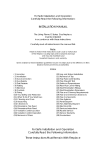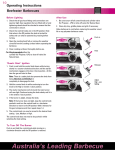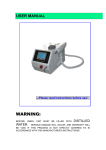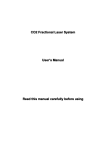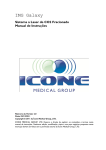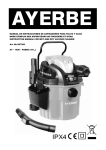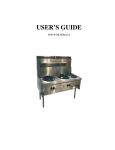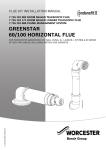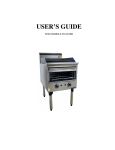Download INSTALLATION MANUAL For Safe Installation and Operation
Transcript
For Safe Installation and Operation Carefully Read the Following Information: INSTALLATION MANUAL The Living Flame G Series Gas fireplace must be installed in accordance with these instructions. Carefully read all instructions in the manual first. Note: Failure to follow these instructions could cause a malfunction of the fireplace causing injury and/or property damage and may also invalidate your household insurance and warranty. Some variation to these installation guidelines may be necessary due to the difference in New Zealand homes and the local authorities. Index ( 1) Location ( 2) Ventilation ( 3) Gas Connection ( 4) Gas Supply ( 5) Test Pressure ( 6) Testing ( 7) Electrical ( 8) Controls ( 9) Fluing (10) Your Safety and Protection (11) What To Do If You Smell Gas (12) Cleaning and Care (13) Unpacking (14) Clearances (15) Dimensions Top Flued (16) Dimensions Rear Flued (17) Control Location (18) Control Operation (19) Removal of Glass (20) Removal of Top (21) Log and Ember Installation (22) Top Flued Joint Sealing (23) Flue Draught Test (24) Surfaces Temperatures (25) Rear Flue Corner Fitting (26) Wall Penetration Fittings (27) Wall Penetration Dimensions (28) Flue and Chimney Requirements (29) Flue and Chimney Clearances (30) Flue Components (31) Flue Systems (32) Parts Diagram (33) Fan Assembly Diagram (34) Electrical Kits (35) Services Instructions (36) Routine Service (37) Service Warranty (38) Guarantees For Safe Installation and Operation Carefully Read the Following Information: These Instructions Must Remain With Fireplace (1) Location The fireplace should be located 1. Out of high traffic areas. 2. Out of strong draughts. 3. Away from furniture and drapes. 4. Where the flue system can be correctly installed without damaging the structure of the building, checking that the flue and its shielding will be able to pass through the ceiling space and roof without interfering with any structural timberwork. 5. Where there is sufficient access for safe operation and maintenance. 6. Where there is a flat and level surface of combustible or non-combustible material. 7. Where there is sufficient flue clearance around the flue terminal or cowl in relationship to the roof. 8. Where there is access to a gas line or the gas line can be brought to the fireplace in accordance with NZS 5261. 9. Where there is access to an electrical supply should a fan or electrical control system be fitted. 10. Where there is unobstructed adequate ventilation to allow correct combustion and operation of the fireplace. 11. Where the fireplace can be used to optimise the Radiant and Convection Heat given off by the fireplace. 12. The heater does not require a hearth or floor protector to stand on, but should be fixed to the floor (2) Ventilation This fireplace has been designed to operate by drawing its combustion air and dilution air from the surrounding room. Adequate make up air or ventilation shall be provided in accordance with NZS 5261. This fireplace has also been designed to draw room air into the heater and to circulate it as convected heat. The blocking up or modifying of any of the air ways of the fireplace in any way could create a hazardous situation either through overheating or poor ventilation. (3) Gas Connection A Gas Certification must be carried out for the installation, connection and associated flue system. All installation work should be carried out by a suitably trained and qualified person to comply with installation code NZS 5261 and then certified by a Craftsman Gas fitter. Before installation commences, check the data plate on the fire to verify that the fire is set up to suit your type of gas supply. Field conversion to suit a different gas is not always practicable. This fireplace is supplied with a 10mm flare connection mounted at the bottom rear right hand side of the fireplace, as seen from the front. A gas line capable of supplying a minimum of 50mJ should be brought to the fireplace with a 10mm soft copper tail and flare nut. This is to be connected to the flare inlet fitting at the rear of the fireplace. As an alternative, a flexible hose, bayonet and socket can be fitted to connect the gas supply to the G series fireplace. Other systems of connection may be used in accordance with NZS 5621. (4) Gas Supply NATURAL GAS Inlet Standing Pressure 2.0 Kpa U/LPG - PROPANE 2.75 Kpa Maximum Inlet Pressure 4.0 Kpa Set Up Pressure High 1.4 Kpa Low 0.8 Kpa High 2.5 Kpa Low 1.5 Kpa If inlet pressure exceeds 4.0 Kpa then damage will occur and may result in a hazardous condition. (5) Test Pressures Test nipple is located on injection elbow before main burner. For access, remove front inspection cover by means of two 4mm Allen screws, located at top corners of inspection cover. (6) Testing Turn off fire and loosen test nipple screw Fit 6mm tube and test gauge securely Turn on fire, check pressure setting high and low Adjust control valve setting where required, refer control system Data Sheet and Rating Plate for correct adjustment and settings. Turn off fire, remove gauge and tube. Secure test nipple screw and replace cover. (7) Electrical The Standard G Series fireplace will operate with no need for an external power supply. This model has a thermocouple safety device that when heated by the pilot flame generates a millivolt supply enough to operate and control the main burner. The fireplace when installed should be electrically grounded in accordance with the electrical regulations. If the fireplace is supplied with electrical, electronic control system or a fan you should have supplied or obtained the appropriate electrical and operating instruction to that control system. (8) Controls Customers Requirements 1. Show customer the position of manual or electrical control system 2. Ask the customer to operate controls. 3. Insure the customer fully understands the control system and they can operate them satisfactorily 4. If the controls system fitted is unable to be operated satisfactory then a alternative control system may be selected from our control options range (ref back to dealer or sales representative) . NOTE 1. The cost of providing power supply and wall sockets in reach of the appliance power cords is not included. 2. Some controls are available as inbuilt units, their costs may differ from those plug in and they require installation by an electrician at the customers cost. Note Fires with electric or electronic controls will not operate without power Electric 1 STAGE (ON/OFF - Manual High / Low ) On request and at further cost an electric on / off control kit with plug in power cord can be fitted to the fire. You light the pilot manually using the control then manually select high flame. Plug in the power cord. Then the main burner can be turned on and off by the wall switch controlling the power point. The pilot flame is not controlled by the wall switch. High/Low flame is still controlled manually by the push button. Electric 2 STAGE (ON/OFF - HIGH/LOW ) On request and at further cost, an electric on /off - high / low control kit with plug in power cords can be fitted to the fire. These can be either plugged into a separate socket controlled by a separate wall switch or by wall mounted controls You light the pilot manually using the control then manually select high flame. One control lead and plug to operate the On/Off control exactly as described above and the second control lead and plug to operate the high flame, When turned off gives low flame. The on/ off control when turned off over rides the High/Low control and turns the fire off. The pilot ignition and operation is still manual. Electric REMOTE ON/OFF ( plug in or inbuilt ) On request and at further cost, a hand held remote control and a plug in relay can be supplied. Plug the relay into the power socket, and then plug the power cord from the fire into the relay. Light the pilot, select gas on and turn on the wall switch as described above. The main burner can now be turned on and off by the hand held remote control. High/Low flame is still controlled manually by the push button. THERMOSTAT CONTROL ( Plug in or wall mount ) On request and at further cost, a plug in or wall mount thermostat can be supplied. Plug in Plug the plug in thermostat into the power socket, then plug the on / off or high / low power cord into the thermostat. The electric control will then be automatically operated by the room temperature selected. Wall mount The wall thermostat will need to be installed by an electrician in a suitable location The electric control will then be automatically operated by the room temperature selected. TIME CONTROL On request and at further cost, a plug in or wall mount timer can be supplied. Plug in Plug the plug in timer into the power socket, then plug the on / off power cord into the timer. The electric control will then be automatically operated by the selected time. Wall mount The wall timer will need to be installed in a suitable location by an electrician The electric control will then be automatically operated by the selected time. (9) Fluing This fireplace must be vented to outside atmosphere. Fluing must be in accordance with the NZS 5261 and all local body by laws. Flues must be unrestricted. The flue should be checked for correct height and location in relation to the roof and other objects in close proximity. (Refer to flue Clearance sheets). We recommend that the flue should be at least 3,6 metres long. Stand the heater in its proposed position, taking care to observe the minimum clearances shown. Drop a plumb-bob from the ceiling to hang centrally in the flue spigot of the fire and mark the position on the ceiling. Drive a nail through at this position and inspect the ceiling and roof to ensure that the flue and its air space liner will be at least 25mm clear of any combustible material. The first two lengths of 150mm flue should be of vitreous enamel to match the colour of the fireplace, the remainder to be of stainless steel with an outer galvanised liner to be installed where the flue is concealed. There must be a minimum clearance of 150mm between these enamel flue lengths and a combustible wall or any other material. A minimum clearance of 25mm is required between the flue and air space liner where it penetrates the ceiling. A suitable flashing should be used to seal the roof and flue liner. A suitable cowl and wind skirt is required to prevent down draught and keep rain from coming down the flue. Flues must be sealed to prevent damage from water or products of combustion leakage. Flues should be inspected and tested annually. Flues should have a minimum draught of -1mm wg. Flues should have a minimum rise of no less than 10° horizontally where flue is to be offset. (10) Your Safety and Protection A fireguard to BS Standard 6539 or 6778 should be used for the protection of young children, the elderly and infirm. Do not store or use flammable vapours or liquids in the vicinity of this fireplace or any other gas appliance. Do not place combustible materials on or around fireplace. Know where your gas shut off valves are located (11) What to do if you smell Gas Open windows Do not try to light any gas appliance Do not use any electrical appliance or switches Do not use the telephone in your home Turn off the gas supply to your house at the gas meter shut off valve, or the shut off valves at your gas bottle location. Call your local Gas fitter from a neighbours house (12) Cleaning and Care Glass Front Clean only when cold. Use standard glass cleaner (Mr Muscle etc) and soft kitchen paper. Spray on, wipe off Vitreous Enamel Clean only when cold. Use soft cotton cloth with warm soapy water or glass cleaner, to remove marks and finger prints ,finish with soft cotton cloth and a light spray of Pledge or equivalent. Note: Ensure fireplace is cold before the fire is cleaned. Do not touch the glass when hot or in use. Do not wipe hot glass with nylon based cloths.







